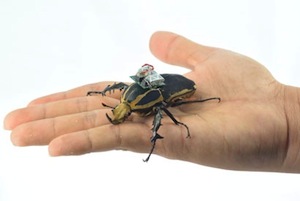Look, Up in the Sky! Cyber Beetle Could Tackle Tight Rescue Missions
- By Dian Schaffhauser
- 03/17/15
 Forget about wireless drones. Try giant wireless beetles from tropical Africa outfitted with gear for surveillance and search and rescue operations. An international research team that has been working with the beetles since at least 2009 for just these purposes recently made breakthroughs that allow them to steer the beetles from a remote location more precisely.
Forget about wireless drones. Try giant wireless beetles from tropical Africa outfitted with gear for surveillance and search and rescue operations. An international research team that has been working with the beetles since at least 2009 for just these purposes recently made breakthroughs that allow them to steer the beetles from a remote location more precisely.
The project, profiled in an article in Current Biology, has been underway for years. But the latest iterations use a miniature radio system to control turns in the insects through electrical stimulation and demonstrate that the beetle's third axillary muscle (one near the rear) kicks into action during those turns.
Scientists working on the project come from both University of California Berkeley's Department of Electrical Engineering and Computer Sciences and the School of Mechanical and Aerospace Engineering at Singapore's Nanyang Technological University.
The Mecynorrhina torquata is a sturdy insect, with males measuring up to 3.3 inches and capable of weighing nearly up to an ounce and a half. For the experimentation the researchers outfitted their flying creatures with a backpack consisting of a tiny, off-the-shelf microcontroller and a built-in wireless receiver and transmitter. Six electrodes were connected to the beetle's optic lobes and flight muscles. Power is supplied by a 3.9-volt micro lithium battery and weighs between a 30th and a 50th of an ounce.
"Beetles are ideal study subjects because they can carry relatively heavy payloads," said study lead author Hirotaka Sato, an assistant professor at the Singapore institution. "We could easily add a small microphone and thermal sensors for applications in search-and-rescue missions. With this technology, we could safely explore areas not accessible before, such as the small nooks and crevices in a collapsed building." Sato began working on the project when he was a postdoctoral researcher at UC Berkeley.
"This is a demonstration of how tiny electronics can answer interesting, fundamental questions for the larger scientific community," said Michel Maharbiz, an associate professor at Berkeley and the study's principal investigator. "Biologists trying to record and study flying insects typically had to do so with the subject tethered. It had been unclear if tethering interfered with the insect's natural flight motions."
By going with a wireless system, the scientists could record neuromuscular movements in natural, free flight, enabling them to see that the 3Ax muscle, as it's referred to, was used in turning. "Since the 1800s, this coleopteran muscle was thought to function solely in wing folding," said Sato.
According to the researchers, signals were transmitted to the beetle backpack during testing every millisecond, directing the beetles to take off, turn left or right or even hover in mid-flight. While the beetles were untethered, they were flying in a closed room equipped with eight 3D motion capture cameras.
The work was funded in part by three organizations: the Nanyang Assistant Professorship; the Agency for Science, Technology and Research in Singapore; and the National Science Foundation.
A video of the experiment is posted on YouTube.
About the Author
Dian Schaffhauser is a former senior contributing editor for 1105 Media's education publications THE Journal, Campus Technology and Spaces4Learning.